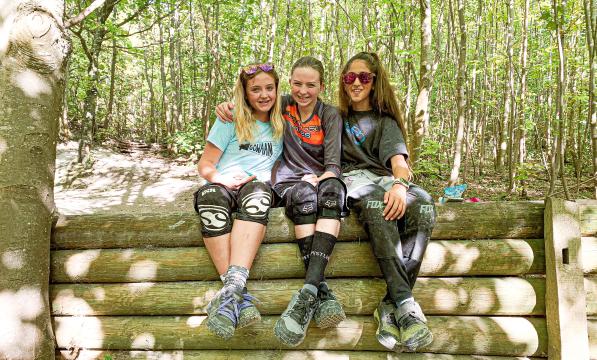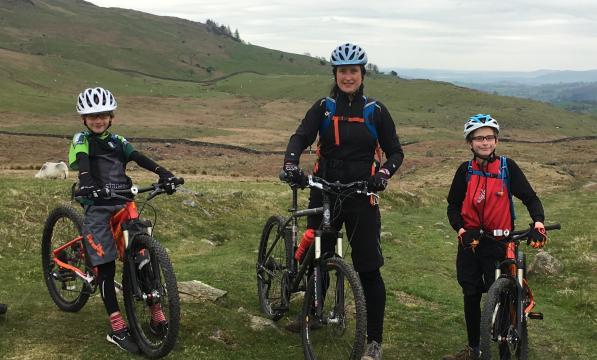Guide to cycling with teenagers

As children enter their secondary school years, cycling can become a fraught subject for families. At one extreme you may have a teen who refuses to get on a bike, with issues such as peer pressure, body image and health risks from inactivity to contend with. At the other end of the spectrum, you may have a youngster who wants to take advantage of the freedom a bike gives to break away from parental restrictions.
In theory, as your child matures the possibilities for cycling open up. No longer do you need to find flat, short, traffic-free routes as family rides can start to explore further afield on a variety of terrains. However, there are some basics to think about before you head off on a family adventure.
Cycling is a skill that requires practise, so don’t expect your child to have magically acquired fabulous bike-handling skills just because they’ve grown a few inches or started a new school.
If they haven’t cycled regularly through childhood, then you need to give them the opportunity to develop confidence on two wheels. Don’t introduce drop handlebars, skinny tyres or gnarly mountain bike trails until they have the right skills.
If your teen has a disability they’ll need extra support with their cycling, get in touch with your local inclusive cycling centre or project for access to non-standard cycles.
Size matters
Having a correctly fitting bike is important. If you want your child to enjoy cycling then a good-quality, lightweight bike will be much more fun to ride (and hold its value better) than a heavy bike that is poorly made.
Kids grow quickly, so consider renting bikes (if you don’t ride very frequently), buying second hand, or for a long-term option take a look at a bike-leasing scheme.
Traffic awareness
When my eldest son asked to ride on the road by himself for the first time it posed a big dilemma. He’d been well trained and had lots of experience riding on the road with me, but was he safe enough to manage without my guidance?
Traffic awareness and road safety is something that must be built up over time, and constantly reinforced. If you’re not happy that your child is safe to cycle in traffic, then parental wisdom needs to overrule offspring protestations. For more information read Cycling UK’s guide to cycling on the road with children.
Embrace technology
The lure of the screen is often blamed for the growing levels of obesity in young people, but technology isn’t necessarily all bad. Smart watches, route planners and performance trackers can be just the incentive digital natives need to get out on two wheels.
If mum or dad says it’s time to get some exercise there’s a likelihood that eyes will roll, but a virtual reminder that a weekly cardio goal will be missed can see even the most reluctant exerciser power up their various devices and start pedalling.
Don’t force your choices on them
Just because you’re an avid road cyclist, mountain biker or cycle tourer doesn’t mean that your child is going to develop the same passion. Think of ways you can get them to try out different cycling experiences:
- Does your local track have an open day?
- Can you hire mountain bikes at a trail centre?
- Would they like to try out cyclocross racing or BMX?
- How can you incorporate cycling as a family into your everyday activities?
- What about a weekend bikepacking trip? Stay at a youth hostel or hotel if you don’t have or can’t borrow the equipment.
- Will a turbo-trainer get them exercising?
Cycling at this age should be fun so don’t push your teen to compete or expect them to ride extremes in terms of distance or terrain, unless they’re happy to do this. If you help them to discover their own passions at their chosen pace, they’re more likely to do it willingly.
Image is everything, except when it comes to safety
Being spotted by classmates in head-to-toe Lycra or hi-viz can be incredibly embarrassing for some young people. Discuss what they are happy to wear that gives the appropriate degree of protection and comfort required for the type of cycling they’re doing. Be willing to adapt your preconceptions if required.
Decide your stance on helmets and visibility (including use of lights), explain it coherently and then stick to it. Remember that at whatever age, season-specific cycling gloves are a good way to stop a ride being ruined by cold fingers!
Two-wheeled friendships
Throughout the teenage years the influence of friends becomes increasingly important. Cycling with someone of the same age will be far more enjoyable than tagging along with mum or dad. Consider inviting their friends along when you’re planning a ride or find out which of your cycling pals have similar-aged kids and arrange a ride together.
You can also encourage your teenager to make new cycling friends – ask if your local cycle club has opportunities to meet and ride with others of a similar age and ability. At some point they will be old enough to ride without the adults, so ensure you’ve instilled the basics of bike maintenance and physical safety.
Cycling selfies
If you do manage to get your offspring out on a bike ride, make sure you don’t humiliate them by sharing it on social channels without their permission – or you risk never getting them on a bike again.
If you’re looking for cycling role models, there are many YouTubers and Instagrammers sharing their carefully curated cycling exploits with the world. If your child decides to start making their own cycling footage, check they’re not pushing safety or legal boundaries to get more likes.
You don’t have to leave the house to have a great bike ride
Still riding your bike outside? You’re so last century! The new generation of cycle trainers (such as indoor cycling game Zwift) are perfect for digital natives. They can ride with others or alone, for leisure or competition, and enjoy stunning scenery along the way.
If body image or peer pressure make being seen on a cycle outside an issue, these problems disappear when you’re safely inside your own home. You can wear what you want, get hot and sweaty and not worry about being seen.
Keep on cycling!
Let’s face it, there are times when the hormones kick in, and there’s nothing you can say or do to persuade your darling offspring onto a bike. My friend Julia gave me good advice about this. As soon as her teenage son and daughter were old enough to be at home without safety concerns, she’d go riding without them if there was a hint of moaning.
On her return she’d enthuse about how fun the ride was and the delicious café stop at the end serving hot chocolate (with extra cream and marshmallows) and huge slices of scrummy cake. They usually graced her with their presence the next time, and now she has two grown-up kids with a real passion for cycling.
As with every aspect of parenting, cycling will pose challenges and opportunities as your child grows. Persevere and keep on being a cycling role model for them, and at some stage you should be able to proudly watch as they pedal off into the distance, leaving you puffing and panting behind. Be patient, though, as it probably won’t be this weekend…






